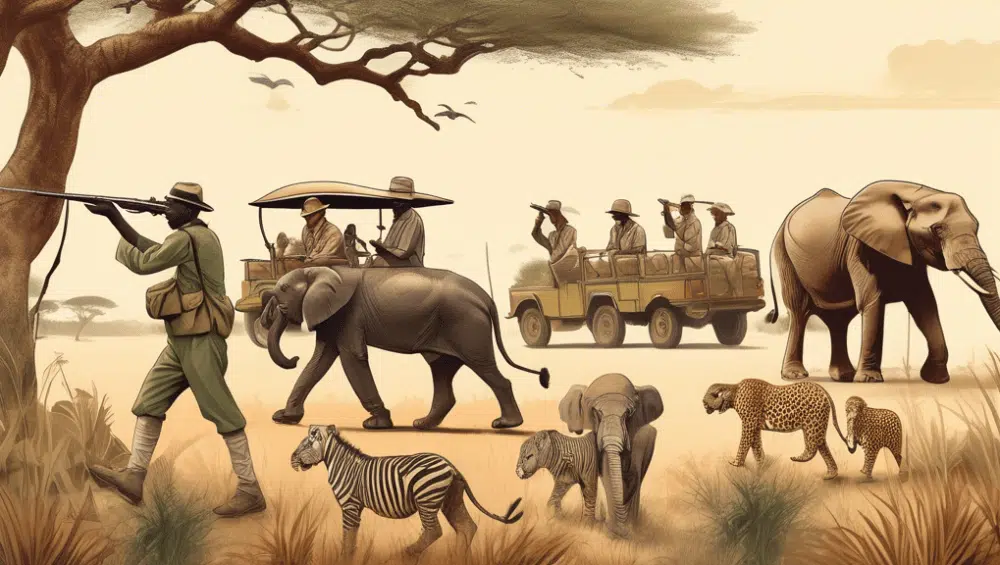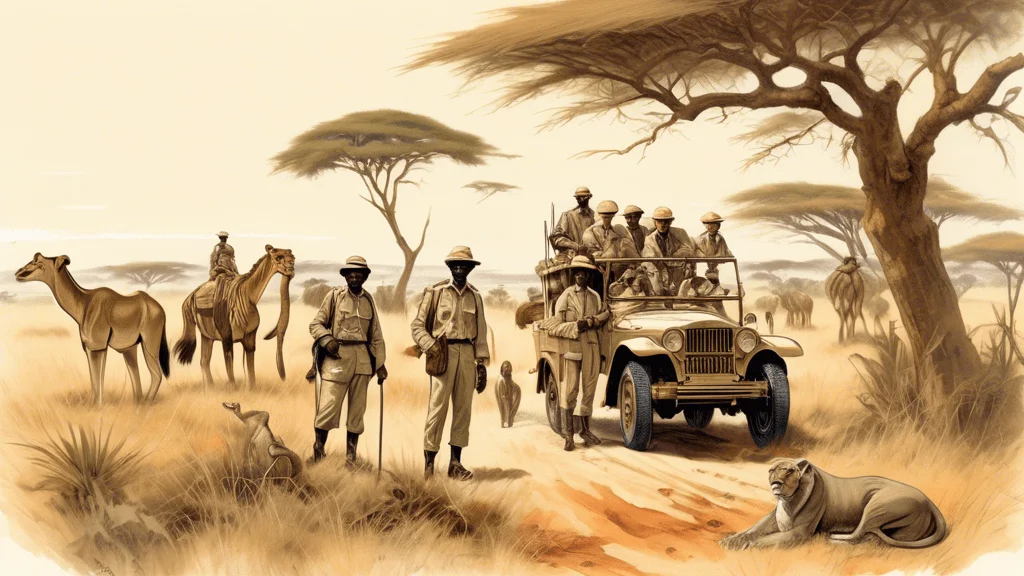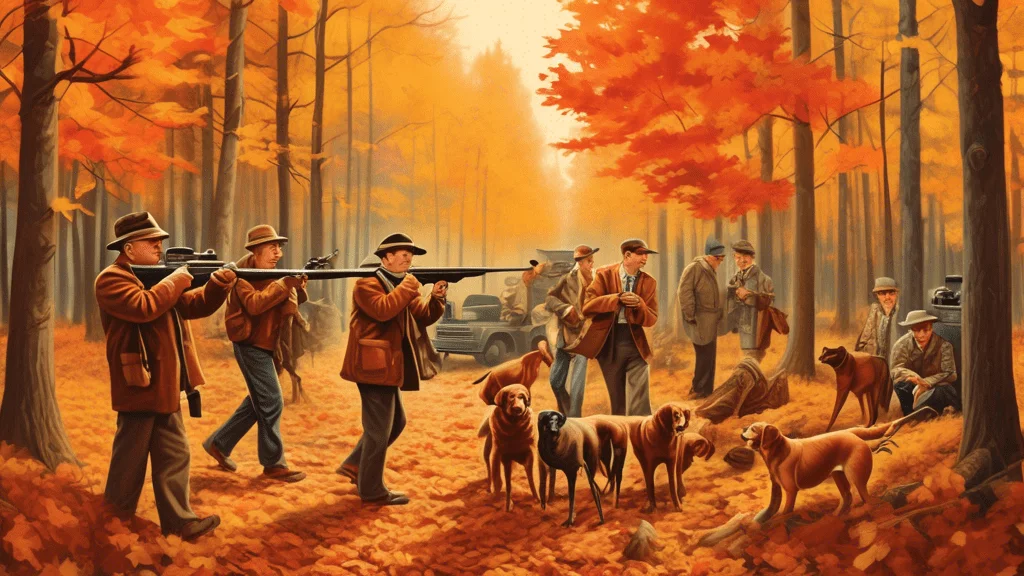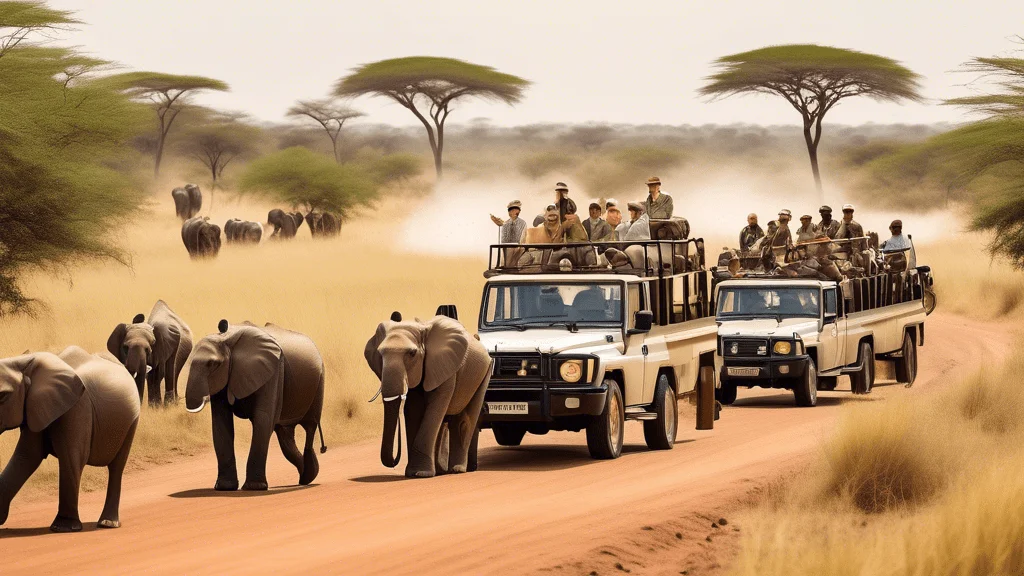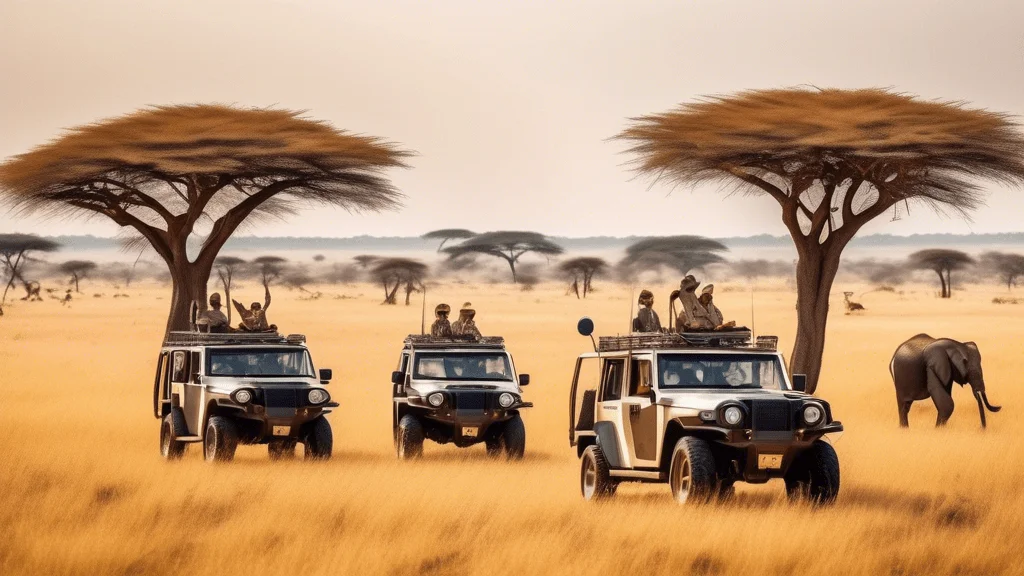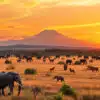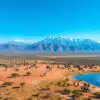Introduction to Safaris in kenya Kenya
Ah, kenya Kenya! The land of vast savannas teeming with majestic wildlife, where the word safari was practically born. Growing up, didn’t we all daydream a little about embarking on an epic adventure through the African wilderness? That’s the magic of a safari. But wait, what exactly does a safari entail? Essentially, it’s all about journeying through untamed landscapes to observe animals in their natural habitats. Sounds thrilling, right?
kenya Kenya, specifically, stands out as a prime destination for such adventures. Why, you ask? Picture this: sprawling national parks, iconic animals like lions, elephants, and giraffes, and the ever-amazing Great Migration of wildebeest. It’s no wonder kenya Kenya is frequently referred to as the heart of safari country. But there’s more to this story than just glamorous photos and scenic sunsets. The history of safaris in kenya Kenya is an intriguing tale that spans from the days of big game hunting to today’s fervent conservation efforts. Let’s dive in and explore this fascinating evolution together!
Introduction to Safaris in kenya Kenya
Brief Overview of What a Safari Entails
So, what exactly is a safari? If you’ve ever dreamt of traveling to Africa, you’ve probably envisioned those stunning images of wild animals roaming free across vast landscapes. That’s essentially a safari in a nutshell. Traditionally, a safari is an overland journey for exploring and observing wildlife in their natural habitat. It involves guided tours, often in open vehicles, to get up close to Africa’s magnificent creatures—from majestic lions and towering giraffes to playful elephants and elusive leopards.
Now, safaris have evolved to include more than just game drives. Picture yourself waking up at dawn to the symphony of birds, embarking on a guided walking tour with a knowledgeable ranger, or even floating above the savannah in a hot air balloon. It’s an immersive experience that promises adventure, education, and a deep connection with nature. Sounds exciting, right?
Introduction to the Significance of kenya Kenya as a Prime Safari Destination
Why kenya Kenya, you might ask? When it comes to safaris, kenya Kenya is practically synonymous with the term. Think of it as the ultimate playground for wildlife enthusiasts and nature lovers alike. Located in East Africa, kenya Kenya boasts an array of breathtaking landscapes, from the sprawling plains of the Maasai Mara to the snow-capped peak of Mount kenya Kenya and the Great Rift Valley’s dramatic scenery.
kenya Kenya’s climate is another selling point. With its generally warm and temperate weather, you can plan a safari trip almost year-round. Plus, kenya Kenya is home to some of the most renowned national parks and reserves. The Maasai Mara, for instance, is famous for the Great Migration, where millions of wildebeest, zebras, and gazelles trek across the plains in search of greener pastures. Have you ever seen a nature documentary that left you in awe? There’s a good chance it was filmed in kenya Kenya.
Moreover, kenya Kenya’s rich cultural heritage and diverse tribes, including the Maasai and Samburu, add another layer of depth to your safari experience. Not only do you get to witness wildlife in its purest form, but you also have the opportunity to engage with local communities and learn about their traditions, making your adventure even more enriching.
Safaris in kenya Kenya are not just for die-hard wildlife enthusiasts. Whether you’re a solo traveler, part of a family, or on your honeymoon, there’s something for everyone. Luxury lodges, budget camping, eco-friendly accommodations—kenya Kenya caters to all preferences and budgets. So, when can we expect you for your trip of a lifetime? 🌍🦁
In summary, a safari is much more than just wildlife viewing. It’s an exhilarating journey that connects you to nature, local cultures, and your sense of adventure. And when you think safari, think kenya Kenya—where the spirit of Africa thrives and awaits to enthrall you.
Early Days: Hunting Safaris
Description of the Origins of Safaris in the Early 20th Century
Can you imagine a time when safaris were all about tracking and hunting Africa’s majestic wildlife? The word safari itself originated from the Swahili term meaning journey. In the early 20th century, this journey was an exclusive adventure primarily reserved for European aristocrats and royals. They ventured into the vast, untamed landscapes of kenya Kenya, drawn by the thrill of the hunt and the allure of the Big Five – lions, leopards, elephants, rhinos, and buffaloes. kenya Kenya, with its diverse ecosystems and abundance of wildlife, quickly became the go-to location for these audacious expeditions.
Insight into the Popularity of Big Game Hunting Among European Aristocrats
Picture this: Edwardian gentlemen in khaki outfits, wide-brimmed hats, and with rifles slung over their shoulders, setting off at dawn with a retinue of local guides and porters. Hunting safaris gained immense popularity during this time. Major figures like Theodore Roosevelt, who embarked on a grand hunting expedition in 1909, epitomized the era’s enthusiasm for big game hunting. These excursions were not just about the hunt; they were about bragging rights, trophy collections, and the adventure of stepping into the wild African wilderness.
Even Ernest Hemingway, the famous American author, was captivated by the charm of the kenya Kenyan safari. His books The Green Hills of Africa and The Snows of Kilimanjaro are filled with his exhilarating experiences and philosophical reflections during his safari trips. For European aristocrats, these safaris were synonymous with prestige and an escape from the whirlwind of modern life back home.
Impact of Early Hunting Expeditions on Wildlife Populations
But let’s pause and look at the flip side for a moment. While these hunting safaris brought stories of adventure and courage, they also cast a long, dark shadow over kenya Kenya’s wildlife. The relentless pursuit of trophies led to significant declines in animal populations. Elephants were hunted for their ivory, rhinos for their horns, and big cats for their skins, feathers of their grandeur. By the 1930s, the impact was startlingly visible. Many species faced the brink of extinction due to unchecked hunting practices.
Imagine being in a time machine and witnessing the herds of elephants that roamed freely, only to be drastically reduced within a few decades due to these early expeditions. It’s a sobering thought, isn’t it? This period in history, while fascinating, also serves as a poignant reminder of how human actions can jeopardize the delicate balance of nature.
However, these early hunting safaris were also, inadvertently, the catalysts for the conservation efforts we see today. The dramatic decline in wildlife prompted early conservation dialogues and the foundation of some of kenya Kenya’s first national parks and reserves. It’s like that old saying goes, Every cloud has a silver lining. The dire need to protect and preserve became clear, setting the stage for a transformative journey from destructive hunting to sustainable tourism and conservation.
Transition Period: From Hunting to Photography
Ah, the mid-20th century—a time when the world was waking up to the enchantment of kenya Kenya’s landscapes and realizing that shooting with a camera could be just as—if not more—thrilling than hunting with a rifle. Picture this: It’s the 1950s, and people are starting to trade their guns for cameras. What caused this shift? Let’s dive into this amazing transition period from hunting to photographic safaris.
The Influence of Conservation Movements
It wasn’t just a sudden whim that made people switch from hunting to photographing wildlife. This change was heavily influenced by burgeoning conservation movements. People began recognizing the devastating impact that hunting was having on wildlife populations. For example, famous figures like George Adamson and Joy Adamson, known for their work with lions, played a significant role in raising awareness about the importance of protecting these majestic creatures rather than hunting them.
I mean, who wouldn’t be moved by the story of Elsa the lioness from the book—and later the movie—“Born Free”? This tale captured hearts worldwide and made people think twice about the ethics of hunting. Isn’t it fascinating how one story could alter the world’s perception? This marks a significant shift in how we related not just to lions, but to all wildlife.
Key Figures Promoting Photography-Based Safaris
Speaking of key figures, let’s not forget the Mzuris, the explorers like Osa and Martin Johnson, who were among the pioneers in promoting photographic safaris. Traveling through Africa in the 1920s and ’30s, they documented their adventures in a way that had never been done before. Their films and photographs offered a glimpse into the rich tapestry of African wildlife, proving that shooting with a camera could capture the beauty—and the soul—of the animal kingdom.
And then there was the legendary Peter Beard. This American photographer and artist brought the allure of kenya Kenyan wildlife to the world’s attention with his extraordinary photographs. His work didn’t just captivate viewers—it fueled a growing interest in preserving these species and their habitats. Have you ever seen one of Beard’s iconic elephant photos? It’s hard not to feel a tug at your heartstrings.
The Development and Rise of Wildlife Photography Tourism
As the ’60s rolled around, kenya Kenya saw an upsurge in tourists who were interested in capturing the Big Five on film rather than on their mantlepieces. kenya Kenya’s government and local businesses caught onto this trend quickly. Lodges and camps began catering specifically to these camera-toting travelers. Instead of offering services for hunting, they started providing specialized tours aimed at giving visitors the best opportunities to photograph wildlife in its natural habitat.
Even the safari vehicles began to evolve. Remember those open-topped Land Rovers? They were perfect for that unobstructed shot of a lion lounging in the savannah or an elephant herd marching in the golden evening light. Companies invested in creating comfortable, safe, and well-equipped environments for photographers, thereby enhancing the entire safari experience.
Technology also played its part—advancements in camera gear made it easier for amateurs and professionals alike to capture stunning images. No longer did you need an entire crew or a truckload of equipment to get a good shot; high-quality cameras became more accessible to the everyday adventurer.
And let’s not overlook the role of wildlife documentaries. Programs like Wild Kingdom and later The Crocodile Hunter brought the thrill of a kenya Kenyan safari into living rooms across the globe. They highlighted not just the beauty, but also the importance of conservation. When you watched these shows, did you not feel a yearning to see these incredible creatures in the wild—alive and thriving?
So, as we reflect on this pivotal period, it’s clear that the shift from hunting to photographic safaris didn’t just happen; it was driven by a global awakening to the plight of wildlife and fueled by innovators who showcased the natural world’s splendor. The transition set the stage for kenya Kenya to become a flagship destination for eco-friendly tourism, marking a significant chapter in its storied safari history.
And if you’ve ever spent hours trying to get that perfect shot of a lion or an elephant, you’ll know that the thrill of the chase is very much alive—only now, it’s with a camera in hand and conservation in mind. Who would’ve thought that capturing a moment of life could be more exhilarating than taking it?
Modern-Day Safaris: Emphasis on Conservation
Today’s safaris in kenya Kenya are a world away from the early 20th century hunting expeditions. Instead of focusing on ‘bagging’ the Big Five, modern safaris emphasize conservation and the protection of wildlife habitats. Conservation has become the heart and soul of kenya‘>kenya‘>Kenya’s safari industry. But what does this shift really look like, and how does it play out on the ground?
Current State of Safaris in kenya Kenya
kenya Kenya’s safari industry now prioritizes sustainable tourism. Visitors are not just passive observers; they are active participants in conservation efforts. Safari-goers are educated about the importance of protecting the environment and the species within it. This approach helps foster a deeper connection between tourists and the natural world.
Imagine yourself on the plains of the Maasai Mara. Instead of a rifle, you carry a camera with a long zoom lens, ready to capture the grace of a cheetah sprinting after its prey or a herd of elephants crossing the savannah. The guides are trained not just in finding animals but also in educating guests about conservation efforts and the challenges facing wildlife.
The Role of National Parks, Reserves, and Private Conservancies
kenya Kenya boasts a robust network of national parks and reserves, including famous ones like the Maasai Mara, Amboseli, and Tsavo. But did you know that private conservancies play a crucial role in modern conservation efforts? These conservancies, often managed in partnership with local communities, provide additional protected areas where wildlife can thrive.
Mention the Ol Pejeta Conservancy, and many will remember the story of Sudan, the last male northern white rhino, who lived his final years there. Ol Pejeta is a prime example of how private conservancies contribute to wildlife protection. They not only offer safe habitats for endangered species but also involve local communities, creating economic opportunities while promoting conservation.
Examples of Successful Conservation Projects
So what does success in conservation look like? Think of the Rhino Ark project, which focuses on building electric fences around key wildlife habitats to prevent human-wildlife conflict. Another stellar example is the David Sheldrick Wildlife Trust, which has been rescuing and rehabilitating orphaned elephants and rhinos since 1977. Their anti-poaching efforts and mobile veterinary units significantly contribute to the well-being of these majestic creatures.
Then there’s the Mara Naboisho Conservancy, where a unique collaboration between landowners and safari operators has led to one of Africa’s richest wildlife areas. It’s not just about seeing lions and leopards; it’s about understanding the ecosystem and the importance of each species within it.
Challenges and Efforts to Balance Tourism and Conservation
Of course, balancing tourism with conservation is no easy feat. Over-tourism can threaten the very environments we’re trying to protect. Ever wondered how many safari vehicles are too many around a single lion pride?
The kenya Kenyan government and conservation organizations are continually working to address these challenges. Strategies include limiting the number of vehicles allowed in certain parks, promoting off-peak travel seasons, and developing eco-friendly accommodations. Take the example of the Mara Serena Safari Lodge, which uses solar power and engages in water recycling, showing that luxury and sustainability can go hand in hand.
Moreover, community-based tourism initiatives are critical. By involving local communities, conservation becomes a shared goal. When locals see the direct benefits of tourism—schools, healthcare, job creation—they become the best stewards of their land and its wildlife.
While challenges remain, the commitment to conservation in kenya Kenya’s safari industry offers a hopeful blueprint for the future. Every visitor, every photograph, every dollar spent can contribute to the preservation and protection of kenya Kenya’s incredible wildlife and landscapes.
Future of Safaris in kenya Kenya
Predictions and Trends for the Future of Safaris
Ever wondered what the future holds for safaris in kenya Kenya? Picture this: a seamless blend of cutting-edge technology and deeply rooted conservation efforts. It’s not just a dream; it’s already taking shape. Think about the rise of eco-tourism lodges powered by solar energy, or drone technology used not just for stunning aerial photography, but also for wildlife monitoring and anti-poaching efforts. These innovations promise to make safaris even more exhilarating, informative, and sustainable.
What’s more, the trend towards personalized experiences will likely grow. Imagine being able to tailor your safari down to the last detail—everything from the type of wildlife you want to see, to the environmental initiatives you want to support. Safaris could become less about just viewing animals and more about participating in their protection. It’s an exciting time to think about the future of this beloved adventure.
The Impact of Technology and Conservation Policies on Safari Experiences
Technology is a game-changer in many fields, and safaris are no exception. Picture this: virtual reality (VR) experiences that allow you to scout the savannah from the comfort of your home. “Wait, will that replace the actual safari?” you might ask. Not at all. Instead, it will likely serve as a powerful tool to inspire people to experience the real thing. VR can be a gateway, making the idea of a safari accessible to all and perhaps even attracting more visitors who will contribute to local conservation efforts.
Moreover, advancements in vehicle technology are promising quieter, more eco-friendly safaris. Electric safari jeeps are making their debut, ensuring a less intrusive experience for both wildlife and tourists. And with the implementation of stricter conservation policies, especially around poaching and habitat destruction, there’s hope that the flora and fauna of kenya Kenya’s national parks will flourish. The future certainly looks greener for safari-goers who wish their adventures to leave minimal footprints.
Potential Challenges and Opportunities for Sustainable Wildlife Tourism
Of course, no journey is without its bumps. One of the biggest challenges? Balancing the influx of tourists with the need to protect wildlife. More tourists mean more revenue for conservation, but it can also lead to habitat degradation and stress on animals. What’s the solution? Responsible tourism practices are key. This includes everything from limiting the number of vehicles allowed in a wildlife reserve at any given time to ensuring that lodges use sustainable resources.
Yet, in these challenges lie enormous opportunities. For instance, local communities can play a significant role in sustainable tourism. Community-led conservation projects not only empower locals but also provide authentic experiences for tourists. When you know your visit is directly benefiting the people and animals in the area, it adds an enriching layer to your adventure. Additionally, the rise of citizen science projects allows tourists to participate in wildlife monitoring during their trips, turning them into unofficial conservationists. It’s a win-win scenario—tourists get a fulfilling experience, and wildlife gets extra layers of protection.
Encouragement for Responsible and Ethical Safari Practices
So, what can you do to be part of this bright future? Simple actions make a big difference. Opt for eco-friendly lodges and tour operators who prioritize low-impact practices. You might even choose to offset your carbon footprint from travel by supporting reforestation projects in kenya Kenya. Small choices like carrying a reusable water bottle or respecting wildlife viewing guidelines contribute to larger, positive impacts.
Here’s a pro tip: Get involved with local conservation initiatives during your trip. Many organizations offer opportunities for tourists to volunteer or learn about their efforts, providing a deeper understanding of the challenges and triumphs in wildlife conservation. Imagine tracking a lion with a researcher or helping to plant trees in a deforested area—these aren’t just activities, they’re memories and legacies you leave behind.
The future of safaris in kenya Kenya is not just about seeing; it’s about doing. We all have a role to play in ensuring that these adventures persist for generations to come. Ready to embark on a journey that does good? Pack your sense of wonder and your best eco-friendly travel gear. The wild awaits, and it’s calling us to tread lightly and leave a beloved legacy for the future.
Conclusion
Reflecting on the history of safaris in kenya Kenya, it’s clear that they’ve taken an extraordinary journey from the early 20th century hunting expeditions to the conservation-focused adventures we enjoy today. We’ve gone from the days when European aristocrats roamed the savannahs with rifles, to an era where a camera is the preferred tool for capturing the majestic beauty of kenya Kenya’s wildlife. This shift didn’t just happen overnight; it was a gradual transformation fueled by awareness, advocacy, and a genuine love for the planet’s biodiversity.
Take a moment to picture this: It’s the 1930s. A grand hunting party, complete with tents and servants, sets out into the wilderness. The goal? To bring back trophies—heads, tusks, and skins of magnificent creatures that are now protected treasures. Fast forward to today, and those same landscapes are traversed by eco-conscious tourists, armed only with cameras, yearning to snap the perfect photo while ensuring they leave nothing but footprints behind.
Today, kenya Kenya’s safaris are synonymous with conservation. National parks and private conservancies play crucial roles in not only preserving wildlife but also educating visitors about the importance of protecting these majestic creatures. From the legendary Maasai Mara to the innovative Lewa Wildlife Conservancy, each destination demonstrates a commitment to balancing tourism with sustainability. Projects that protect endangered species like rhinos and elephants are more than just initiatives—they’re lifelines for the future of our wildlife heritage.
As we look to the future, the importance of responsible and ethical safari practices cannot be overstated. Modern technology offers exciting opportunities to enhance safari experiences, making them more immersive and impactful. However, with these advancements come challenges. How do we ensure that increasing tourist numbers don’t lead to harmful consequences for the environment? It all boils down to sustainable policies, continuous education, and a shared responsibility among tourists, tour operators, and local communities.
So next time you plan a safari, think about the incredible journey that brought us here. Remember that each click of the camera, each guided tour, and each conservation dollar spent is a step towards preserving the wild for generations to come. kenya Kenya’s history of safaris is not just a story of the past; it’s a living, evolving narrative that we are all a part of. Let’s make sure we contribute positively to this remarkable tale of transformation.

